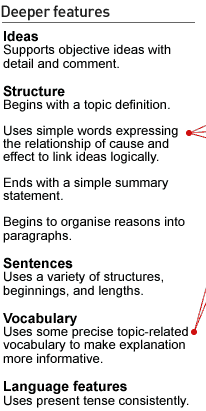


Lewis has explained a natural phenomenon with reasonable clarity and logic. He includes his audience in the explanation and speaks directly to them for effect.



This class focused on writing explanations for five weeks. Initially, the teacher emphasised discussion and reading, to scaffold the students' thinking about explanations.
The class brainstormed a list of topics under the headings "I wonder why ..." and "I wonder how ..." (for example, "I wonder why trees lose their leaves?"). The teacher wrote several of these topics on cards, which she gave to the students to discuss in pairs. These discussions helped them to understand the purpose of explanations and to describe cause-and-effect relationships.
The teacher then used guided reading to help develop their understanding of the structure and language features of explanations. She used the School Journal articles "Plants That Store Water" (2.3.93) and "The Dance of the Air" (2.1.95) for this purpose. She asked the students to:
• consider initial paragraphs and think about how the author got the reader's attention
• find information that explained the phenomenon
• identify words that helped to explain the phenomenon
• consider the impact of the writing
• consider the importance of having prior knowledge of the topic.
The students then began to write explanations on a variety of topics, of which "What Makes Talk?" was the fourth.
Rather than print resources, the teacher decided to use discussion and direct experiences as motivation for this writing. She generated discussion by posing the question, "What makes talk?" The students discussed what body parts could be involved and how they might work. They used mirrors to observe themselves talking, touch to feel their voice boxes, and rubber bands to demonstrate vibrations.
The teacher then asked the students to write an explanatory article for an audience who had limited knowledge of the topic (the next-door class). The class used their experience of reading and writing explanations to establish some criteria for their articles, including:
• opening with a definition of "talk"
• being explicit in describing the body parts and how they work
• concluding with a summary statement.
At this stage, the students were confident with writing explanations and were able to write for up to 30 minutes. While they were writing, the teacher roved, guiding them and talking to them about their pieces.
Teacher-student conversations
During drafting:
Teacher: "Communicate" - with whom? [Paragraph 1.]
Lewis: With everyone.
Teacher: Do you think you need to expand your introduction to include that idea?
After drafting:
Teacher: Where are the vocal cords? [Paragraph 2.]
Lewis: In your voice box.
Teacher: Do your readers need to know that?
As a result of such conversations, Lewis revised his explanation for impact and sense.
Integrating reading and writing
Classroom reading programmes, especially guided and shared reading, provide opportunities for students to identify how phenomena can be explained in written and visual texts. Teachers could expose their students to explanatory texts. Examples include:
From the School Journal:
"Plants That Store Water" 2.3.93
"The Dance of the Air" 2.1.95
"How Dreading Works" 4.3.97
"Virus Warning" 4.3.97
"Fun With Photos" 4.2.00
From Connected:
"The Eye" 3, 1999
"Night Lights" 3, 1999
Students could discuss the vocabulary, language features, and diagrams contained in such texts and practise them in their own writing. In addition, teachers could encourage students to explain phenomena from a wide range of fiction and non-fiction texts.
Teachers could also use generic reference texts and texts on the World Wide Web.
To move Lewis towards the next learning step, the teacher could help him to focus on:
• Ideas &endash; supporting ideas and reasons with greater and more precise detail.
• Structure
• Vocabulary - developing his range and ability to select words, especially adjectives, adverbs, and verbs, that enhance his explanations.
The teacher could do this by:
• encouraging Lewis to explore texts with examples of these features
• setting specific goals and criteria with Lewis and providing specific feedback
• modelling texts that have examples of the language features of explanation.